Una delle nostre raccomandazioni in alto per gli utenti di WordPress è quella di imparare a mantenere i database di WordPress.
WordPress è scritto utilizzando PHP come linguaggio di scripting e MySQL come sistema di gestione dei database. Per utilizzare WordPress, non è necessario imparare nessuno dei due.
Tuttavia, una conoscenza di base di questi due elementi potrebbe aiutarvi a risolvere i problemi e ad aumentare la vostra conoscenza del funzionamento di WordPress (dietro le quinte).
In questo articolo spiegheremo come WordPress utilizza il database, compresa un’introduzione alle tabelle predefinite del database di WordPress. Vi mostreremo anche come gestire un database di WordPress utilizzando phpMyAdmin, compresa la creazione di backup del database, l’ottimizzazione del database di WordPress, la correzione del database di WordPress e altro ancora.
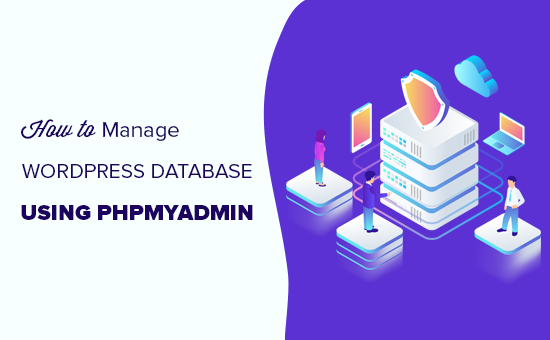
Questa è una guida completa sulla gestione del database di WordPress, pertanto abbiamo aggiunto un indice per facilitare la navigazione:
- What Is a Database, and How Does WordPress Use it?
- What Is phpMyAdmin?
- How to Access phpMyAdmin
- Understanding WordPress Database Tables
- Managing the WordPress Database Using phpMyAdmin
- Creating a WordPress Database Backup Using phpMyAdmin
- Creating a WordPress Backup Using a Plugin
- Importing a WordPress Database Backup via phpMyAdmin
- Optimizing Your WordPress Database in phpMyAdmin
- Fixing WordPress Issues Using phpMyAdmin
- Reset WordPress Password Using phpMyAdmin
- Adding a New Admin User to WordPress Using phpMyAdmin
- Change a WordPress Username via phpMyAdmin
- Other Useful phpMyAdmin Tricks
- Securing Your WordPress Database
Che cos’è un database e come lo usa WordPress?
Un database è un sistema per organizzare e recuperare i dati. Consente al software di gestire i dati in modo programmabile.
Ad esempio, WordPress utilizza PHP (un linguaggio di programmazione) per memorizzare e recuperare i dati dal database.
Le informazioni memorizzate in un database di WordPress comprendono post, pagine, commenti, categorie, tag, campi personalizzati, utenti e altre impostazioni di WordPress. Approfondiremo questo aspetto più avanti nel corso del tutorial, quando parleremo delle tabelle del database di WordPress.
Quando si installa WordPress per la prima volta, viene chiesto di fornire il nome del database, l’host, il nome utente e la password. Queste informazioni sono memorizzate nel file di configurazione, che si chiama wp-config.php.
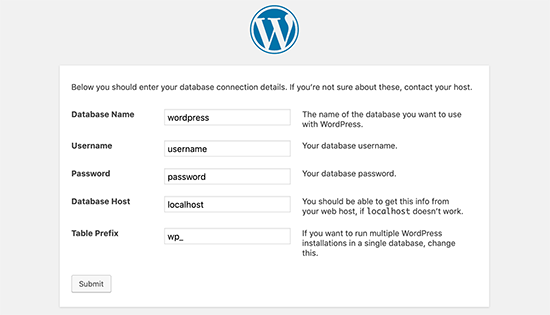
Durante l’installazione, WordPress utilizza le informazioni fornite sul database per creare tabelle e memorizzare i dati predefiniti dell’installazione all’interno di tali tabelle.
Dopo l’installazione, WordPress esegue delle query su questo database per generare dinamicamente le pagine HTML per il vostro sito web o blog.
Questo rende WordPress estremamente potente perché non è necessario creare un nuovo file .html per ogni pagina che si desidera creare. WordPress gestisce tutto in modo dinamico.
Dove viene memorizzato il mio database di WordPress?
WordPress utilizza MySQL come sistema di gestione del database, un software installato sul vostro server di hosting WordPress. Anche il database di WordPress è memorizzato sullo stesso server.
Questa posizione non è accessibile nella maggior parte degli ambienti di hosting condivisi. Tuttavia, se si dispone di un piano di hosting VPS o di un server dedicato, è possibile utilizzare gli strumenti della riga di comando per individuare il database.
Il più delle volte si trova nel seguente percorso:
/var/lib/mysql/nome_del_tuo_database
Tuttavia, questo potrebbe variare da un fornitore di hosting all’altro.
È importante tenere presente che non è necessario accedere al file del database stesso. Si possono usare altri strumenti come phpMyAdmin per gestire il database.
Che cos’è phpMyAdmin?
phpMyAdmin è un software basato sul web che consente di gestire i database MySQL utilizzando il browser web. Offre un’interfaccia facile da usare che consente di eseguire comandi MySQL e operazioni sul database.
Si può anche usare per sfogliare e modificare tabelle, righe e campi del database. Permette inoltre di importare, esportare o cancellare tutti i dati di un database.
Come accedere a phpMyAdmin
PhpMyAdmin è preinstallato in tutte le principali società di hosting WordPress. È possibile trovarlo nella sezione Database del cruscotto cPanel del vostro account di hosting. Di seguito è riportato un esempio di schermata dal pannello di controllo di Bluehost:
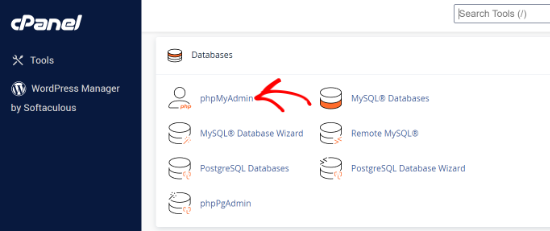
A seconda del vostro fornitore di hosting, l’interfaccia del vostro cPanel potrebbe apparire diversa da quella dello screenshot qui sopra. Tuttavia, è possibile trovare l’icona di phpMyAdmin nella sezione Database.
Facendo clic su di esso si aprirà l’interfaccia di phpMyAdmin, dove è possibile selezionare il database di WordPress dalla colonna di sinistra. Successivamente, phpMyAdmin visualizzerà tutte le tabelle del database di WordPress.

Diamo un’occhiata alle tabelle del database di WordPress.
Capire le tabelle del database di WordPress
Ogni installazione di WordPress ha 12 tabelle predefinite nel database. Ogni tabella del database contiene dati per diverse sezioni, caratteristiche e funzionalità di WordPress.
Osservando la struttura di queste tabelle, si può facilmente capire dove sono memorizzate le diverse parti del sito web. Attualmente, un’installazione predefinita di WordPress crea le seguenti tabelle:
Nota: il prefisso wp_ è anteposto a ogni nome di tabella del database in modo predefinito, ma è possibile modificarlo durante l’installazione.
- wp_commentmeta : Questa tabella contiene le meta informazioni sui commenti pubblicati su un sito web WordPress. La tabella ha quattro campi: meta_id, comment_id, meta_key e meta_value. Ogni meta_id è collegato a un comment_id. Un esempio di meta-informazione sui commenti è lo stato di un commento (approvato, in attesa, cestino).
- wp_comments : Come suggerisce il nome, questa tabella contiene i commenti di WordPress. Contiene il nome dell’autore del commento, l’URL, l’email, il commento e altro ancora.
- wp_links : Per gestire i blogroll creati da versioni precedenti di WordPress o dal plugin Link Manager.
- wp_options : Questa tabella contiene la maggior parte delle impostazioni del sito WordPress, come l’URL del sito, l’email dell’amministratore, la categoria predefinita, i post per pagina, il formato dell’ora e molto altro. La tabella delle opzioni è utilizzata anche da numerosi plugin di WordPress per memorizzare le impostazioni dei plugin.
- wp_postmeta : Questa tabella contiene le meta-informazioni relative ai post, alle pagine e ai post type personalizzati di WordPress. Esempi di meta-informazioni sui post sono il template utilizzato per visualizzare una pagina, i campi personalizzati, ecc. Alcuni plugin utilizzano questa tabella anche per memorizzare i dati dei plugin, come le informazioni di WordPress SEO.
- wp_posts: il nome dice post, ma in realtà questa tabella contiene tutti i post type o, per meglio dire, i tipi di contenuto. Questa tabella contiene tutti i post, le pagine, le revisioni e i post type personalizzati.
- wp_termmeta : Questa tabella consente agli sviluppatori di memorizzare metadati personalizzati per i termini delle loro tassonomie personalizzate. Ad esempio, WooCommerce la utilizza per memorizzare i metadati relativi agli attributi dei prodotti e alle categorie.
- wp_terms : WordPress dispone di un potente sistema di tassonomia che consente di organizzare i contenuti. I singoli elementi della tassonomia sono chiamati termini e sono memorizzati in questa tabella. Ad esempio, le categorie e i tag di WordPress sono tassonomie e ogni categoria/tag al loro interno è un termine.
- wp_term_relationships : Questa tabella gestisce la relazione tra i post type / tipi di contenuto di WordPress e i termini della tabella wp_terms. Ad esempio, questa è la tabella che aiuta WordPress a determinare se la pubblica X è nella categoria Y.
- wp_term_taxonomia: questa tabella definisce le tassonomie per i termini definiti nella tabella wp_terms. Ad esempio, se si ha il termine“WordPress Tutorials“, questa tabella contiene i dati che dicono che è associato a una tassonomia chiamata categoria. In breve, questa tabella contiene i dati che aiutano WordPress a distinguere tra un termine che è una categoria, uno che è un tag e altro ancora.
- wp_usermeta : Contiene le meta informazioni su chi siamo utenti registrati sul sito web.
- wp_users : contiene informazioni sugli utenti come nome utente, password, email dell’utente e altro.
Gestione del database di WordPress con phpMyAdmin
Il database di WordPress contiene importanti impostazioni di WordPress, nonché tutti i post del blog, le pagine, i commenti e altro ancora. È necessario fare molta attenzione quando si utilizza phpMyAdmin, altrimenti si potrebbe finire per eliminare accidentalmente dati importanti.
Per precauzione, si dovrebbe sempre creare un backup completo del database. Questo vi permetterà di ripristinare il database come era prima.
Vediamo come creare facilmente un backup del database di WordPress.
Creare un backup del database di WordPress con phpMyAdmin
Per creare un backup del database di WordPress da phpMyAdmin, fare clic sul database. Poi, nel menu in alto, fate semplicemente clic sulla scheda “Esporta”.

Nelle versioni più recenti di phpMyAdmin, viene richiesto un metodo di esportazione. Il metodo rapido esporta il database in un file .sql. Il metodo personalizzato offre più opzioni e la possibilità di scaricare i backup in formato zip o gzip.
Si consiglia di utilizzare il metodo personalizzato e di scegliere zip come metodo di compressione. Il metodo personalizzato consente anche di escludere le tabelle dal database.
Supponiamo di aver utilizzato un plugin che ha creato una tabella del database e di non utilizzarlo più. In questo caso, si può scegliere di escludere tale tabella dal backup.
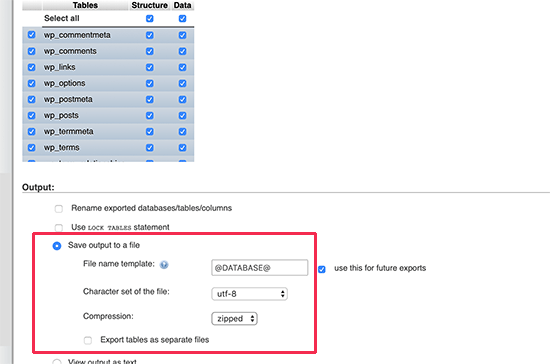
Il file del database esportato può essere importato in un altro o nello stesso database usando la scheda Importa di phpMyAdmin.
Creare un backup di WordPress utilizzando un plugin
Mantenere backup regolari del vostro sito WordPress è la cosa migliore che possiate fare per la sicurezza di WordPress. Sebbene il database di WordPress contenga la maggior parte delle informazioni del sito, mancano ancora diversi elementi piuttosto importanti, come i file dei modelli, le immagini, i caricamenti, ecc.
Tutte le immagini sono memorizzate nella cartella uploads della directory /wp-content/. Anche se il database ha le informazioni su quale immagine è allegata a un post, è inutile se la cartella delle immagini non contiene quei file.
Spesso i principianti pensano che un backup del database sia tutto ciò di cui hanno bisogno. Questo non è vero. È necessario un backup completo del sito che includa i temi, i plugin e le immagini.
Sebbene la maggior parte delle società di hosting dichiari di avere backup giornalieri, vi consigliamo di mantenere i backup da soli, per ogni evenienza.
Nota: se utilizzate una soluzione di hosting WordPress gestita come WP Engine, questa crea backup giornalieri.
Per la maggior parte delle persone che non utilizzano WP Engine, è necessario utilizzare un plugin di backup di WordPress per impostare backup automatici di WordPress sul proprio sito.
Suggerimento: Volete eseguire normali backup del vostro sito web e del database? Potete utilizzare i servizi di manutenzione e assistenza WordPress di WPBeginner. Il nostro team di esperti imposterà backup di routine nel cloud, gestirà e ottimizzerà il database del vostro sito e ne ottimizzerà le prestazioni.
Importare un backup del database di WordPress tramite phpMyAdmin
phpMyAdmin consente anche di importare facilmente il database di WordPress. È sufficiente lanciare phpMyAdmin e selezionare il database di WordPress.
Successivamente, è necessario fare clic sul link “Importa” nel menu in alto.
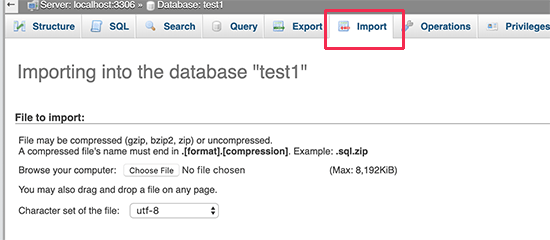
Nella schermata successiva, fare clic sul pulsante “Scegli file” e selezionare il file di backup del database scaricato in precedenza.
phpMyAdmin elaborerà ora il caricamento del file di backup e lo importerà nel database di WordPress. Al termine, verrà visualizzato un messaggio di successo.
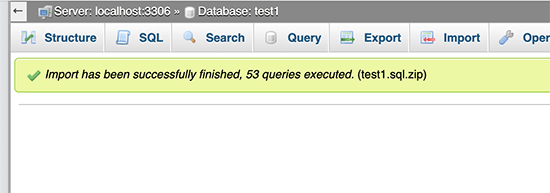
Ottimizzare il database di WordPress in phpMyAdmin
Dopo aver utilizzato WordPress per un po’ di tempo, il database diventa frammentato. Ci sono sovraccarichi di memoria che aumentano le dimensioni complessive del database e il tempo di esecuzione delle query.
MySQL dispone di un semplice comando che consente di ottimizzare il database. Basta andare su phpMyAdmin e cliccare sul database di WordPress. Verrà visualizzato un elenco delle tabelle di WordPress.
Fare clic sul link “Controlla tutto” sotto le tabelle. Accanto ad esso, è presente un menu a tendina “Con selezionati”. È necessario fare clic su di essa e scegliere “Ottimizza tabella”.
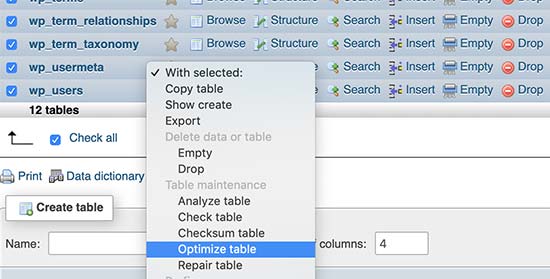
Ottimizza il database di WordPress deframmentando le tabelle selezionate. In questo modo le query di WordPress verranno eseguite un po’ più velocemente e si ridurranno leggermente le dimensioni del database.
Risolvere i problemi di WordPress utilizzando phpMyAdmin
Come abbiamo detto in precedenza, phpMyAdmin è uno strumento utile per risolvere alcuni errori e problemi comuni di WordPress.
Vediamo alcuni problemi comuni di WordPress che possono essere facilmente risolti utilizzando phpMyAdmin.
Ripristinare la password di WordPress usando phpMyAdmin
Se avete dimenticato la password di amministrazione di WordPress e non riuscite a recuperarla tramite l’email di smarrimento della password, questo metodo vi permette di reimpostare rapidamente la password.
Per prima cosa, avviare phpMyAdmin e selezionare il database di WordPress. Verranno visualizzate le tabelle del database di WordPress e si dovrà fare clic su “Sfoglia” accanto alla tabella wp_users.
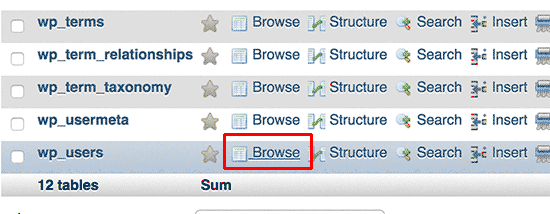
Nota: le tabelle del database di WordPress potrebbero avere un prefisso diverso da quello mostrato nell’immagine.
Ora vedrete le righe nella tabella degli utenti di WordPress. Cliccate sul pulsante “Modifica” accanto al nome utente per il quale volete cambiare la password.
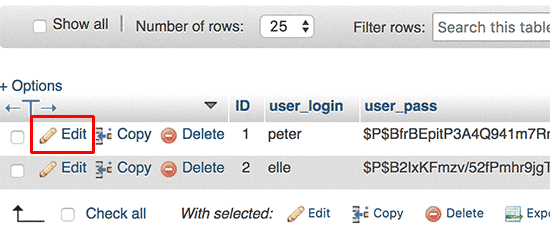
phpMyAdmin mostrerà un modulo con tutti i campi delle informazioni dell’utente.
È necessario cancellare il valore del campo “user_pass” e sostituirlo con la nuova password. Nella colonna “Funzione”, selezionare “MD5” dal menu a discesa e fare clic sul pulsante “Vai”.
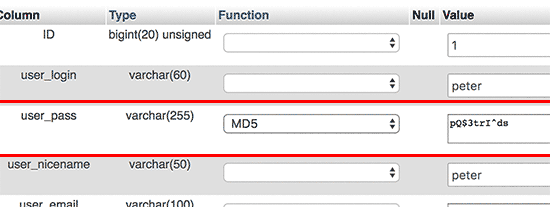
La password viene crittografata utilizzando l’hash MD5 e quindi memorizzata nel database.
Congratulazioni! Avete cambiato con successo la password di WordPress usando phpMyAdmin.
Ora, alcuni di voi si chiederanno perché abbiamo scelto l’hash MD5 per crittografare la password.
Nella versione precedente, WordPress utilizzava l’hash MD5 per criptare le password. Dalla versione 2.5, WordPress ha iniziato a utilizzare tecnologie di crittografia più forti. Tuttavia, WordPress riconosce ancora MD5 per garantire la compatibilità con il passato.
Non appena si accede utilizzando una stringa di password memorizzata come hash MD5, WordPress la riconosce e la modifica utilizzando gli algoritmi di crittografia più recenti.
Aggiungere un nuovo utente amministratore a WordPress usando phpMyAdmin
Supponiamo che abbiate accesso al database di WordPress ma non all’area di amministrazione di WordPress. Sebbene sia possibile modificare la password dell’utente amministratore, ciò impedirà agli altri utenti di utilizzare i loro account.
Una soluzione più semplice sarebbe quella di aggiungere un nuovo utente amministratore tramite phpMyAdmin.
Per prima cosa, è necessario avviare phpMyAdmin e selezionare il database di WordPress. Verranno mostrate le tabelle del database di WordPress, dove è necessario fare clic sul link “Sfoglia” accanto alla tabella wp_users.

phpMyAdmin mostrerà ora le righe della tabella wp_users.
Fare clic sul link “Inserisci” dal menu in alto.
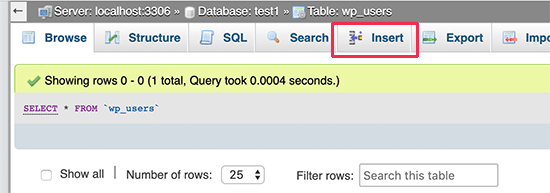
Verrà visualizzato un modulo da compilare per aggiungere un nuovo utente al vostro sito WordPress.
Ecco come si deve compilare ogni campo di questo modulo.
- ID – Si può ignorare, perché viene generato automaticamente.
- user_login – Questo sarà il nome utente di WordPress da utilizzare per accedervi.
- user_pass – È la password di WordPress. È necessario inserire la password e selezionare MD5 nella colonna della funzione.
- nome_utente – È il nome utente URL-friendly che si può usare per accedere.
- user_email – Inserite un indirizzo email valido, in quanto potrebbe essere necessario per ricevere le notifiche di reimposta della password e di WordPress.
- user_url – Aggiungere l’URL del sito web, oppure lasciarlo vuoto.
- user_registered – È necessario selezionare CURRENT_TIME nella colonna della funzione per inserire automaticamente l’ora corrente.
- chiave_di_attivazione_utente – È possibile lasciare vuoto questo campo, che viene utilizzato per approvare la registrazione dell’utente.
- user_status – È possibile lasciare vuoto anche questo campo.
- display_name – È possibile inserire il nome completo dell’utente come si desidera che venga visualizzato negli articoli. Si può anche lasciare vuoto.
Dopo aver compilato il modulo, fare clic sul pulsante “Vai” per inserirlo nel database di WordPress.
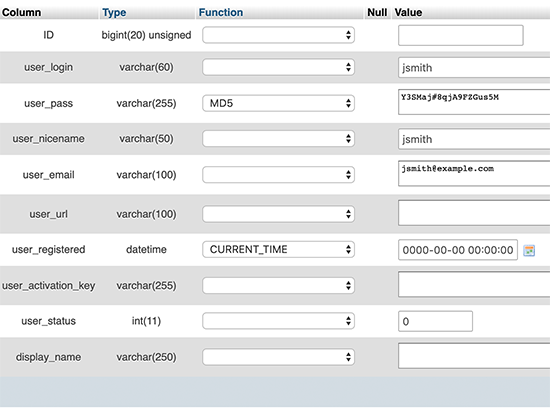
phpMyAdmin eseguirà ora la query MySQL per inserire i dati.
Abbiamo aggiunto l’utente, ma questo utente non ha un ruolo di amministratore sul vostro sito WordPress. Questo valore viene salvato in un’altra tabella chiamata wp_usermeta.
Prima di rendere questo utente un amministratore, è necessario trovare l’ID utente.
È sufficiente fare clic sul link “Sfoglia” accanto alla tabella wp_users per visualizzare una riga contenente l’utente appena aggiunto e il suo ID utente.
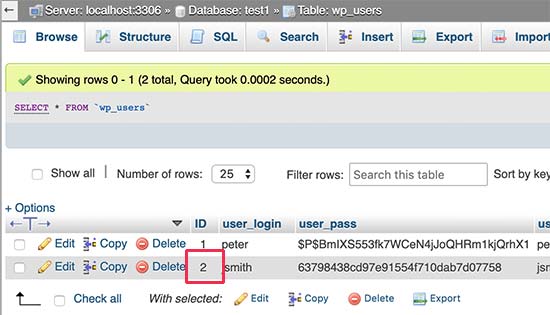
Annotate l’ID utente perché vi servirà nella fase successiva.
Ora, apriamo la tabella wp_usermeta facendo clic sul link “Sfoglia” accanto ad essa.

Successivamente, è necessario fare clic sul link “Inserisci” in alto.
In questo modo è possibile aggiungere una nuova riga alla tabella.

A questo punto viene visualizzato un modulo per l’inserimento di una nuova riga.
Qui si dirà a WordPress che l’utente creato in precedenza ha il ruolo di amministratore.
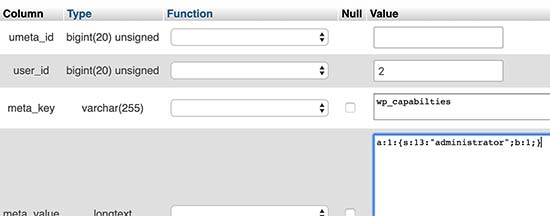
Ecco come compilare il modulo.
- umeta_id – È necessario lasciarlo vuoto, poiché viene compilato automaticamente.
- user_id – Inserire l’ID utente copiato in precedenza.
- meta_key – In questo campo è necessario inserire “wp_capabilities”. Tuttavia, potrebbe essere necessario sostituire wp_ se i nomi delle tabelle di WordPress utilizzano un prefisso diverso.
- meta_value – È necessario inserire il seguente valore serializzato:
a:1:{s:13:”administrator”;s:1:”1″;}
Infine, fare clic sul pulsante “Vai” per salvare le modifiche.
Successivamente, occorre aggiungere un’altra riga per definire il livello dell’utente. Fare clic sul link “Inserisci” nel menu in alto per aggiungere un’altra riga alla tabella usermeta.
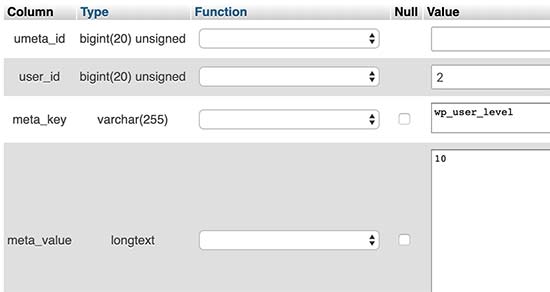
Ecco come compilare il modulo.
- umeta_id – È necessario lasciarlo vuoto, poiché viene compilato automaticamente.
- user_id – Inserire l’ID dell’utente appena aggiunto.
- meta_key – In questo campo è necessario inserire “wp_user_level”. Tuttavia, potrebbe essere necessario sostituire wp_ se i nomi delle tabelle di WordPress utilizzano un prefisso diverso.
- meta_value – Qui è necessario inserire ’10’ come valore del livello utente.
Non dimenticate di fare clic sul pulsante “Vai” per inserire i dati.
È tutto, ora potete visitare l’area di amministrazione di WordPress e accedere con il nuovo utente amministratore aggiunto.
Modificare il nome utente di WordPress tramite phpMyAdmin
Avrete notato che WordPress consente di cambiare il nome completo o il nickname di un utente, ma non il nome utente.
Molti utenti finiscono per scegliere dei nomi utente durante l’installazione che poi vogliono cambiare. Ecco come è possibile farlo tramite phpMyAdmin.
Nota: esiste un modo più semplice per cambiare il nome utente di WordPress utilizzando un plugin.
Per prima cosa, è necessario avviare phpMyAdmin dalla dashboard del cPanel del vostro account di hosting. Dopodiché, è necessario selezionare il database di WordPress.
phpMyAdmin mostrerà le tabelle del database di WordPress. È necessario fare clic sul link “Sfoglia” accanto alla tabella wp_users.

Questa tabella elencherà ora tutti gli utenti registrati sul vostro sito web.
Quindi, fare clic sul link “Modifica” accanto al nome utente che si desidera modificare.
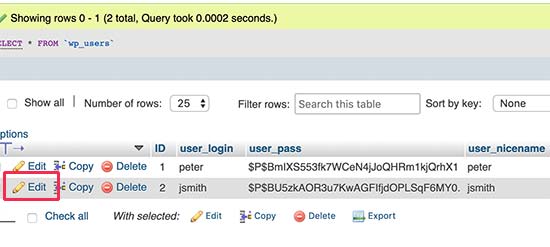
phpMyAdmin mostrerà ora i dati dell’utente.
È necessario individuare il campo user_login e modificare il valore con il nome utente che si desidera utilizzare.
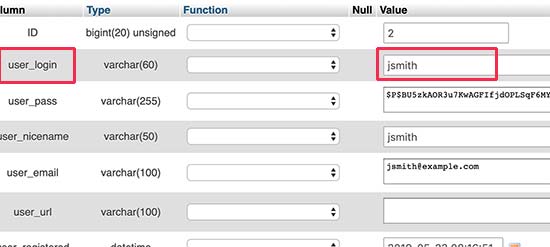
Non dimenticate di fare clic sul pulsante “Vai” per salvare le modifiche. Ora è possibile visitare il sito web e accedere con il nuovo nome utente.
Altri trucchi utili per phpMyAdmin
Il database di WordPress è il motore del vostro sito web. Con phpMyAdmin, potete modificare le impostazioni per migliorare le prestazioni, risolvere i problemi o semplicemente cambiare le cose che non possono essere modificate dall’area di amministrazione di WordPress.
Ecco alcuni altri trucchi che potete usare con phpMyAdmin:
- Disattivare tutti i plugin di WordPress.
- Cambiare il tema di WordPress tramite phpMyAdmin.
- Duplicare il database di WordPress tramite phpMyAdmin.
- Trovare e sostituire il testo nel database di WordPress
Proteggere il database di WordPress
Prima di entrare nel merito, vogliamo sottolineare che ogni sito può essere violato. Tuttavia, ci sono alcune misure che potete adottare per renderlo un po’ più difficile.
La prima cosa da fare è cambiare il prefisso del database di WordPress. Questo può ridurre significativamente le possibilità di attacchi di tipo SQL injection sul vostro database WordPress. Infatti, gli hacker prendono spesso di mira i siti che utilizzano il prefisso predefinito della tabella wp_.
Per le istruzioni passo-passo, consultate il nostro tutorial su come modificare il prefisso del database di WordPress.
Inoltre, dovreste sempre scegliere un nome utente e una password forti per il vostro utente MySQL. In questo modo sarà difficile per qualcuno accedere al database di WordPress.
Per la sicurezza di WordPress, vi consigliamo vivamente di utilizzare Sucuri. È il miglior plugin per la sicurezza di WordPress che cattura qualsiasi tentativo di iniezione di MySQL prima ancora che raggiunga il vostro sito web.
Speriamo che questa guida vi abbia aiutato a imparare la gestione del database di WordPress e a usare phpMyAdmin. Potreste anche leggere la nostra guida su come riparare un database di WordPress e su come aggiungere un gestore di file simile a FTP nella dashboard di WordPress.
Se questo articolo vi è piaciuto, iscrivetevi al nostro canale YouTube per le esercitazioni video su WordPress. Potete trovarci anche su Twitter e Facebook.





Jiří Vaněk
Wow, this is a great article, I have saved it to my favorites. I actually knew some of the tricks in phpmyadmin, but definitely not all of them, and here it’s all beautifully described, including pictures. This article is a goldmine for working with databases and WordPress.
WPBeginner Support
Glad you liked our article
Admin
Nadine
Hi!
Thanks you so much for this tutorial!!! it was really help full!
WPBeginner Support
Glad our guide was helpful
Admin
Abdul
Article is well explanatory and concise. Thank you.
WPBeginner Support
You’re welcome
Admin
Kelvin
Am having problem with the login pageusername how it connect with database
WPBeginner Support
For any issues with your database, you would want to reach out to your hosting provider and they should be able to assist.
Admin
Kevin
A good introduction thank you.
I have several WP sites and several databases.
How can I tell which database belongs to which site?
WPBeginner Support
The wp-config file for each site and that would specify which database they are using. You can see our guide on the wp-config file below:
https://www.wpbeginner.com/glossary/wp-config-php/
Admin
Salman
Perfect… I want to learn
WPBeginner Support
Glad our article can be a good starting point
Admin
Pam Sheets
Awesome! Very well explained quick and to the point.
Thank you,
WPBeginner Support
You’re welcome, glad you liked our article
Admin
Dubravka
Very clear and really good article.
WPBeginner Support
Thank you
Admin
Aviral
Very nice article
WPBeginner Support
Thank you
Admin
Vimal Rathod
You write well I learned a lot from this blog. My question was answered but I also got the information I needed
WPBeginner Support
Glad our content has been helpful
Admin
ajay
I have two totally separate WP websites setup. Different domains, different databases. I manage both of them and they are both hosted on a dedicated server. I am trying to include some basic content that requires just a tad more than an RSS feed. I need to pull data from SITE-1 and display it on SITE-2
WPBeginner Support
If it is a post or page you can go under Tools>Export on the site with the content to select the specific content you want to be transferred and then use Tools>Import on the site to bring in the content
Admin
Dr Eddy
I need more help how to create, a website via word press and how to Host it
Any help..
WPBeginner Support
We have a guide you can follow here: https://www.wpbeginner.com/guides/
Admin
Wadhi
do i need to learn back end development if i use WordPress. I mean aren’t there some plugins which can help me create a website with front-end and back end system. I want a food delivery website
WPBeginner Support
You do not need to learn development to run a WordPress site. Some plugins will give you that kind of editing power but not all of those plugins are needed.
Admin
George
when i clink on new post, this is what i see; Sorry, that didn’t work.
Please try again or come back later.
504 Error. Gateway Timeout.
please help
WPBeginner Support
For the 504 error, you would want to take a look at our article here: https://www.wpbeginner.com/wp-tutorials/how-to-fix-the-504-gateway-timeout-error-in-wordpress/
Admin
Steve Hanzek
I’m looking to create a website that would allow bands and venues to maintain their schedules, and a visitor to select a date and see all the bands playing on that date, and all the venues with bands playing on that date.
I’m proficient with the SQL (mySQL) needed to do the querying, just want to find out if WordPress will let me create custom pages based on the results of a query?
Thanks
WPBeginner Support
WordPress will allow that, for an example plugin that already allows you to search you can take a look at our article here: https://www.wpbeginner.com/plugins/how-to-let-users-filter-posts-and-pages-in-wordpress/
Admin
Kelsei
I am new at a job and just taking over the website. However, I am reaching the Error Establishing Database Connection on the website itself and the login page. The email they used to originally sign up for the website has been deactivated due to her no longer working here. I have searched the files and cannot find the WP files I am seeing being mentioned above. I am unsure what my next steps should be. Any ideas?
WPBeginner Support
For the error establishing database connection, you would want to take a look at our article here: https://www.wpbeginner.com/wp-tutorials/how-to-fix-the-error-establishing-a-database-connection-in-wordpress/
If you reach out to your hosting provider they should be able to assist with swapping the email address to your new email
Admin
Sharwari
Hi my database is automatically created! Can I Rename the database?
WPBeginner Support
Yes, you can, you would want to follow our guide on how to do this here: https://www.wpbeginner.com/wp-tutorials/how-to-change-the-wordpress-database-prefix-to-improve-security/
Admin
Yinka
Hi,
I recently moved by hosting and it affected the frontend of my website which displays “Error Establishing a Database Connection”. So I created a database.
The website contents are in the public_html folder in my cPanel File Manager.
How and where do I move these contents to the database in order to display my actual website?
Thanks.
WPBeginner Support
Rather than moving your content, you would want to take a look at solving the error using our article here: https://www.wpbeginner.com/wp-tutorials/how-to-fix-the-error-establishing-a-database-connection-in-wordpress/
Admin
Kerrie Taylor
Hi, I cannot get WordPress to reset my password. How would I go about doing it using this way?
Thanks
WPBeginner Support
You would log in to your hosting provider to find your phpMyAdmin, depending on the host there are a few places it could be located.
Admin
Miza
Hi, I need help on this.
I’m planning to utilize database to create a system that can be accessed only by our company staff in wordpress.
May I know from where i should started ?
WPBeginner Support
If you’re wanting to create an intranet you could take a look at: https://www.wpbeginner.com/wp-tutorials/how-to-create-a-wordpress-intranet-for-your-organization/
Admin
Miza
How about for existing wordpress? just want to implement system that can be used by our staff only. i mean i want to create a page (basically a service report in our company website – wordpress) that can only be accessed by our staff
WPBeginner Support
If it is only one page you could use the method in: https://www.wpbeginner.com/plugins/how-to-share-private-posts-with-user-groups-in-wordpress/
Mich
Hi,
I recently created a few WordPress sites and I did it through one click WordPress installation in cPanel. What I wanted to know is, “Should I change my WordPress database name and database user name?” Is it something easily hackable if I’m already using a free security plugin like Wordfence?
Thanks!
WPBeginner Support
Most hosting providers’ one-click installations change the database prefix for you to help with that. It is not something that by default is easily hackable and security plugins help even more
Admin
Joachim
This is great. But what if i create a custom site on wordpress and input a form validation input. Is the data going to be automatically stored in the wp_database?
WPBeginner Support
You would need to set up in your form to store the information, it would not be automatic.
Admin
John Certalic
Is it possible to get this information in an email rather than a tweet? It would be more easily accessible for me in an email for future reference. I appreciate all you do for newbies like me. Thank you.
WPBeginner Support
While we don’t have the entire article in our newsletter emails, we’ll be sure to take a look into possibilities.
Admin
polo
Hello Sir, I have hosted my website with someone which has not given me inbuild features of myphp admin.So how to download it on my desktop plz guide .is there othere software required with myphp to download it.
WPBeginner Support
Hi Polo,
You can access phpMyAdmin from your web hosting account. If you have access to your web hosting account, then you can login there and under the databases section you’ll find phpMyAdmin icon.
Admin
Rajat Pandey
Very Informative Thank You
Ayush singh
i have a result table in database and i want to fetch the result of the student by registration number.
i m not getting solution to where to code in the wordpress site….and how to see result of the student by registration number.
Prakash
Use wp_user table
Zziwa Daniel
Thank you so much for the tutorial, its powerful
however I have a question;
I have a database that I have created with workbench and I have imported it to phpmyadmin. however I want to connect with wordpress so that when I submit data through wordpress I can be able to view it in phpmyadmin and I can view it again in wordpress interface that I have created
Ibrahim
Your tutorials has been helpful.
based on a previous tutorial on installing wordpress on PC, I followed the tutorial and it was successful. i developed a website for diabetes association of Nigeria which iam a member too. But my challenge now is how to add registration form for new members to register online and how to get donation online in the website. i need your help please.
WPBeginner Support
Hi Ibrahim,
Please see our tutorial on how to create a custom user registration form in WordPress. As for donations, we are not sure which payment providers you will be using to collect donations. Here is our tutorial on how to accept online donations in WordPress
Admin
Hemant
Is it possible to migrate WordPress database to newly developed web applications?
Jiří Vaněk
If you mean exporting certain tables, then it is possible. In phpmyadmin, the entire database does not have to be exported, but individual tables can be exported as well. E.g. tables with posts that you can then export to another database. Specifically with the contribution, it is also necessary to remember that images and audiovisual content are not stored in the database and are stored on FTP.
Ian de Guzman
Where can i upload the website I made and that can be accessed offline. Thank you in advance.
WPBeginner Support
hi Ian,
If it is a WordPress website, then see our guide on how to move a local site to a live server. You will need a WordPress hosting account for that.
Admin
FirdausShukor
To make your wordpress website can be accessed offline you can use xampp as a local server and you can install wordpress inside htdocs folder in xampp installation folder.
Siva
Thanks a lot.it gave me some clear vision.
Andreas
What if i want to import wordpress menus? Where in the database are the menus stored?
Pooja Raval
thanks…it helps a lot to understand it a bit better..
Laura Panait
Very helpful tutorial, thank you, it actually worked.
Divo
Please where does wordpress store page information. How can I change a page title from the database?
Prerna Rathod
I use contact form 7 for feedback purposes and i store that data in database but now i want that particular data by URL like (abc.com/feedback/5) so it will show the data of id no 5 how i do this in wordpress?
Mirjana
Hello,
I`m planing to make some wp website with registration for specific users ( I have a non profit organisation that has more than 2000 members.) Now, I have the list of them (members) in my Access db with all informations needed. My question is, is it possible to connect this access db with wp db? If yes, how to do that?
Also, every member has a unique ID in my db, which is also a number for the membership card they have. If before mentioned is possible, could I make a field in registration form, beside Username&Pass, that would request that ID number which would be checked from db and if correct, make a registration, if false, deny it?
Hope you understand me cause my englesh is not so grate…
Thanks in advance
Ayomide
I’m having the same problem, please did you figure out a solution?? If you did please, get back to me.
Matthew
Hello, I am preparing to launch my first wordpress blog site under my first website. Testing and learning the blog setup I am wondering how the email stuff is working. I created a comment in response to a post and ticked the email me a notification when posts are done option. And when I made another post I received an email notification. Looking in the tables using phpmyadmin I can see the email address I entered with the comment stored in wp1_comments but cannot see where/how the fact is stored that an email should be sent to that address when a new post is made.
Thank you
Saud Khan
Hi,
Can you please help me that how can I view my blog database because they are not visible anywhere.
snaps attached
Murali
Hi,
I run Certification Services like food certificate, ISI Certificate and etc.,.
I have simple wordpress website (self hosted),
Now, I plan to create Page for my clients to get current status about their Application.
Once they enter (1) Application No. (2) Date of Birth / Mobile number, if match details it will display application status else show error message (like not match given details).
Kindly suggest me which plugin / method suite for my requirement.
Thanks
Tom
Hello
I need some help, because I don’t understand something:
I register a WP website… and install WooCommerce in it. (I use XAMPP localhost on C partition)
So I have a clear WP+WooCommerce site which I’d like to use to create other WP sites too.
So I copy all the WP files from C… to another partition, let’s say D partition
and I also export its database by phpMyAdmin. Now I have a copy of the WP site and its database on D partition.
But what if I’d like to use the copied WP+WooCommerce site (pattern) I’ve created?
It is still contains the same e-mail address and password I used when I registrated on the official site of WP right? So how can I modify that?
I’d like to create a new website (with different admin e-mail and password) but using the same WP+WooCommerce site (pattern) I’ve created before.
Penelope
When I did a database backup and followed the custom options. (following these steps: )
When I hit GO, a file goes to my downloads folder and does nothing. the file is empty. What could I be doing wrong?
Richard
Thank you for the great explanation of how WordPress interfaces to MySQL. Question: We have some blogs our site that are displaying a blank page. The blogs with blank pages have the same information as those that are working properly. I’ve used phpMyadmin to examine the tables and all looks well. Which table does WordPress use to begin the page generation?
WPBeginner Support
It seems like a plugin or theme issue. To find out what’s causing the issue, deactivate all plugins on your site and then switch to a default theme like Twenty Sixteen.
Admin
roj
The video was a little superfluous to the more descriptive written explanation of this article AND, as with many of your videos the narrator speaks too quickly and is thus difficult to understand if you don’t speak American. – even to me as a native English speaker!
Anik
how should i connect the in-build search form with my database to see the search results…
WPBeginner Staff
In wp_comments table you will find comment_author_email and comment_author_IP fields. Note that the wp_ prefix in the comments table may differ in your database.
You can also find comment author email and IP information inside WordPress admin area.
IdolHanz
Which part of the database management system in phpMyAdmin shows a commenter’s IP address and email address?
WPBeginner Staff
phpMyAdmin is not a database management system. It is a utility that allows you to manage your database in a web based graphical user interface.
Your actual database resides on your MySQL database server. Any utility that wants to manage, backup, or make changes to your database will need your database username and password to do so.
BackupBuddy works as a WordPress plugin and your database username and password are already stored in your WordPress configuration file. So it can automatically connect to your database without explicitly asking for your username and password.
Nazim
Is it necessary for any plugin/ tool to access to myphpadmin to backup database.. If not then how backupbuddy creates database backups…
Is backupbuddy require username and password of myphpadmin to access to database…
I am newbie and confused. If you know then please let me know…
Bernhardt Le Mechant
I just wanted to say…thanks…good article! (i was wondering how all this worked).